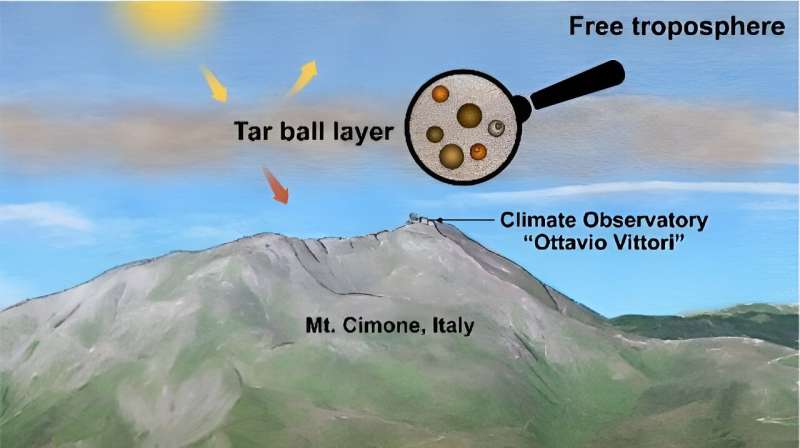This article has been reviewed according to Science X's editorial process and policies. Editors have highlighted the following attributes while ensuring the content's credibility:
fact-checked
proofread
Scientists reveal how tar particles from wildfire smoke absorb and refract solar radiation, light in atmosphere

Days after a wildfire, a type of smoke can linger in the atmosphere that contains tiny, brown, light-absorbing particles known as tar balls. These particles are believed to have a significant impact on Earth's radiative balance, and as a result, a role in both the warming and cooling of the atmosphere.
The formation of these tar balls is not yet well-known, which makes studying their impact on the environment quite difficult, said Claudio Mazzoleni, a physics professor at Michigan Technological University.
While scientists know that these particles influence both warming and cooling of the atmosphere, more information is needed on exactly how and why. A big gap in this knowledge stems from knowing the extent to which these particles absorb, refract, and reflect solar radiation and light—particularly complicated processes to characterize, Mazzoleni said.
As part of a project overseen by the Environmental Molecular Sciences Laboratory (EMSL), Mazzoleni and a multi-institutional team of researchers recently set out to determine exactly how solar radiation from the sun interacts with individual tar balls dispersed over a mountainous region in northern Italy.
Mazzoleni noted that studying individual particles requires advanced scientific expertise and instrumentation, which is why he and his team came to EMSL.
"The best way to do it is through single-particle analysis," he said. "EMSL has all of the tools and expertise needed."
Using a combination of spectroscopy tools, the team determined specific optical properties and the refractive index, or the measure of light bending that occurs when passing from one medium to another, of individual tar balls in the region. The team also estimated the particles' radiative forcing—their impact on the amount of solar energy coming in versus what is radiated back to space.
All of the techniques together help determine the tar balls' potential for having a cooling or warming effect on the region, as well as indicate their impact on other atmospheric processes such as water and ice formation and resulting precipitation, Mazzoleni said. The information also helps reduce uncertainties in climate models pertaining to atmospheric particles that remain after biomass burning events.
The team's research was recently featured on the cover of Environmental Science & Technology.
Complex characterization
What makes tar balls particularly difficult to study is their situation among thousands of other particles in the atmosphere, said Swarup China, integrated research platform leader of Terrestrial-Atmospheric Processes at EMSL and co-author on the paper. Additionally, not all smoke contains tar balls, he said.
Mimicking the composition and atmospheric conditions of these particles within a laboratory setting is also incredibly difficult, China said.
"In the lab, you have a good grasp on what you are generating, but it's still just not the same," he said. "These particles form over periods of time and you need to know the exact atmospheric conditions that form them. That is one of the reasons for looking at them particle by particle."
For their study, the team collected two nighttime aerosol samples directly from the atmosphere at the elevated Climate Observatory Ottavio Vittori on Mt. Cimone, Italy, operated by the Institute of Atmospheric Sciences and Climate. Samples were specifically taken at 7,103 feet.
The team used multimodal microspectroscopy at EMSL to probe the individual particles and characterize their chemical composition and carbon functionalities. Then, they applied scanning transmission electron microscopy coupled with electron energy loss spectroscopy at EMSL to retrieve the refractive index of individual tar balls.
Lastly, they estimated the top of the atmosphere radiative forcing using a model known as the Santa Barbara DISORT Atmospheric Radiative Transfer model. With this, they found that a layer of only tar balls above vegetation would exert a mild positive radiative forcing on a clear sky day, but greater positive radiative forcing when clouds were below the aerosol layer. These both indicate that they would have a warming effect on the atmosphere, with greater warming occurring above cloud cover.
One piece of a larger puzzle
Mazzoleni said their recent findings represent one important piece of a much larger tar balls puzzle that still leaves many questions. Many different kinds of analysis in a variety of different conditions, locations, and other parameters are still required to begin to fully understand tar balls and their impact on the environment, he said.
"Different kinds of forests might burn in different conditions that result in different particles that would still be characterized as tar balls," said Susan Mathai, a postdoctoral researcher at Michigan Technological University and lead author of the paper.
Looking toward the future, the team hopes to gather and analyze even more tar balls from different areas and conditions to add further data to existing models.
"The idea would be to collect samples in places where you receive smoke from fires in different destinations at different times in different years," Mazzoleni said. "You need samples from different types of forests. There is still a lot to do. There is lots of uncertainty as aerosol makeup in the atmosphere is very complex. The more data we have, the more understanding we have of certain conditions and the better our modeling will be."
More information: Susan Mathai et al, Optical Properties of Individual Tar Balls in the Free Troposphere, Environmental Science & Technology (2023). DOI: 10.1021/acs.est.3c03498
Provided by Environmental Molecular Sciences Laboratory




















